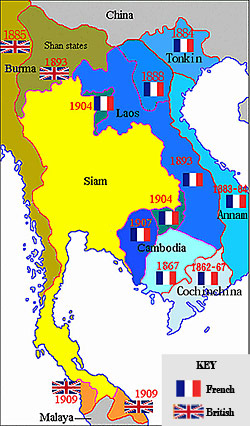Falang
Today I’ve been thinking about the term “falang” since I hear it all the time!
Origins of “Falang”
Laos was a French protectorate from 1887 to 1945. As a result, there is lasting French influence in Laos. Many street names, government signs, and instructions are in French. There are several French cafés in Vientiane, but even more in Luang Prabang. There are many buildings designed using the Lao-French architectural style in Luang Prabang.
Courtesy of Norm and Gayle’s Travels
An example of a French street sign in Laos
In secondary school (high school), students are required to study English, but many also study French. It seems that few people speak French, but there are many government signs and documents that appear in Lao and French. Any way you slice it, Laos’ former colonization by France is still very apparent.

Courtesy of World History Hybrid Course
Map of French colonization in Southeast Asia
Learn more about languages spoken in Laos
Read more about French influence in Laos in recent years
In Lao, “falang” means “French,” but Lao people use this term to refer to any foreigner who is non-Asian. As you can imagine, there are not so many foreigners who live in Laos. (There are more foreigners in Vientiane and Luang Prabang compared to the rest of the country.) I get called “falang” a lot since I stick out a lot. I hear people saying “falang” a lot on the bus, and of course I know they’re talking about me because everyone else on the bus is Lao! It’s not considered rude to call foreigners “falang” here. It’s just normal. Don’t get offended if anyone calls you “falang!”

Courtesy of Regina G Beach
“Falang” written in Lao